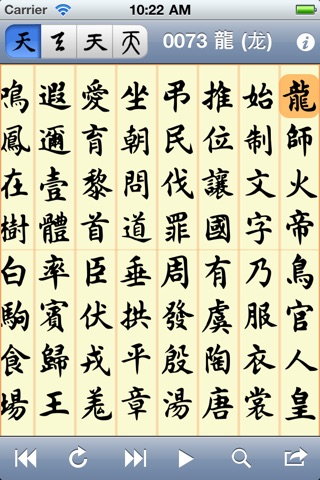
王羲之四體千字文 app for iPhone and iPad
Developer: Next Token Solutions
First release : 10 Apr 2010
App size: 11.22 Mb
- 王羲之書正草隷篆四種字體切換
- 因應現代人之需要,可用中文繁簡體、拼音、英文字意查字
- 粵語及普通話離線發音
- 支持 Retina Display 高清顯示
- 瀏覧紀錄
- 自動播放發音
- 日韓越音標資料
- 以電郵發送文字資料
王羲之,字逸少,晉司徒導從子也。
年十三,謁周顗,顗察而異之,於是知名。及長,辯贍,以骨鯁稱,尤善隸書,為古今之冠,論者稱其筆勢,以為飄若浮雲,矯若驚龍。深為從伯敦、導所器重。時陳留阮裕有重名,為敦主簿。敦嘗謂羲之曰:「汝是吾家佳子弟,當不減阮主簿。」裕亦目羲之與王承、王悅為王氏三少。
起家祕書郎,征西將軍庾亮請為參軍,累遷長史。寧遠將軍、江州刺史。頻召為侍中、吏部尚書,皆不就。復授護國將軍,又推遷不拜。乃以為右軍將軍、會稽內史。嘗與同志宴集於會稽山陰之蘭亭,自為之序以申其志。性愛鵝。山陰有一道士,養好鵝,羲之固求市之。道士云:「為寫道德經,當舉群相贈耳。」羲之欣然寫畢,籠鵝而歸,甚以為樂。後稱病去郡,與東土人士盡山水之游。年五十九卒。
《千字文》,是用來教授兒童基本漢字的一首長韻文。它是一篇由一千個不重複的漢字組成的文章。據說是南朝梁(502年─549年)的梁武帝為其公主練習書法,而委託周興嗣(470年─521年)創作的。原名為《次韻王羲之書千字》。作爲兒童習字的啓蒙讀物,和《三字經》、《百家姓》合稱「三百千」。
李倬《尚書故實》記載粱武帝命大臣殷鐵石模次王羲之書碣碑石的字跡,又要求拓出一千字都不重複,以賜八王。殷鐵石拓出後,此千餘字互不聯屬,粱武帝又命令周興嗣將這一千字編成有意義的句子,「卿有才思,為我韻之。」。周興嗣竟一夜寫成。
千字文是由「天地玄黃」到「焉哉乎也」,總共250個隔句押韻的四字短句構成,整篇文章一字都不重複。
1000 characters in 4 calligraphic styles written by the most famous calligrapher 2000 years ago. This App includes offline Mandarin & Cantonese pronunciations. You may search characters by Chinese traditional & simplified characters, Pinyin, English definitions, and pronunciations of Japanese, Korean & Vietnamese.
This App is ideal for learners around the world who are interested in learning or mastering Chinese Characters (Hanzi).
Wang Xizhi (Chinese: 王羲之, 303–361) was a Chinese calligrapher, traditionally referred to as the Sage of Calligraphy (書聖), lived in Jin Dynasty (265–420).
The Thousand Character Classic (千字文) is a Chinese poem used as a primer for teaching Chinese characters to children. It contains exactly one thousand unique characters. It is said that Emperor Wu of the Liang Dynasty (r. 502-549) made 周興嗣 (Chow Hing-Ji) compose this poem for his prince to practice calligraphy. The original title of the poem was 《次韻王羲之書千字》 and it is sung in the same way in which children learning Latin alphabet writing do with the "alphabet song".
The Thousand Character Classic is composed of 250 phrases of 4 characters each from "天地玄黃" (jyutping: tin1 dei6 jyun4 wong4, pinyin: tiān dì xuán huáng) to "焉哉乎也" (jyutping: yin1 zoi1 fu1 jaa5, pinyin: yān zāi hū yě). It was selected among the calligraphies of 王羲之 (Wang Xizhi), one of the finest calligraphers in China, and composed by Zhou Xingsi, who lived from 470 to 521 in the Liang country in the Southern Dynasty period. The characters of the poem were sometimes used to represent the numbers from 1 through 1000.



